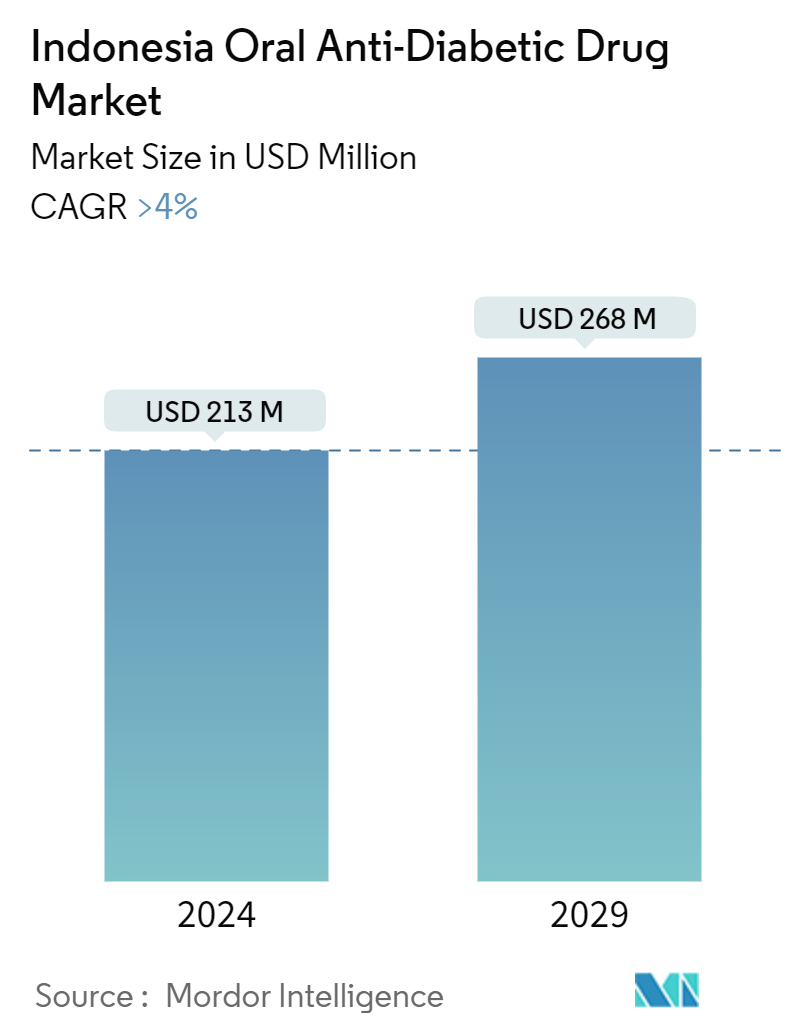Market Size of Indonesia Oral Anti-Diabetic Drug Industry

| Study Period | 2019 - 2029 |
| Base Year For Estimation | 2023 |
| Forecast Data Period | 2024 - 2029 |
| Market Size (2024) | USD 213 Million |
| Market Size (2028) | USD 268 Million |
| CAGR (2024 - 2029) | 4.00 % |
Major Players
*Disclaimer: Major Players sorted in no particular order |
Need a report that reflects how COVID-19 has impacted this market and its growth?
Indonesia Oral Anti-Diabetic Drug Market Analysis
The Indonesia Oral Anti-Diabetic Drug Market size is estimated at USD 213 million in 2024, and is expected to reach USD 268 million by 2028, growing at a CAGR of greater than 4% during the forecast period (2024-2028).
In Indonesia, diabetes is seen as a serious health issue and has raised concerns. The insulin medication category holds a substantial market share. Insulin is used by more than 100 million individuals globally, including 100% of those with Type 1 diabetes and 10% to 25% of those with Type 2 diabetes. Only a few insulin producers operate on the market, and insulin production is complex. As a result, there is intense competition among these companies, which always work to meet patients' needs by offering insulin of the best caliber.
To address the rising number of diabetics in Indonesia, diabetes professionals have developed suggestions for avoiding and controlling the disease. To avoid major side effects such as neuropathy, nephropathy, retinopathy, microvascular disease, and cardiovascular disease, diabetes control is essential.
Modern methods for managing diabetes still include pharmacologic therapy, such as oral medications and insulin, as well as non-pharmacologic therapies, such as lifestyle modifications. These treatments are only accessible because of diabetes education programs that encourage self-care. In Indonesia, healthcare professionals provide diabetes education programs. A lack of skilled healthcare professionals (HCPs) to teach people with diabetes is caused by the limited availability of certified diabetic educators in Indonesia.
Indonesia Oral Anti-Diabetic Drug Industry Segmentation
Orally administered antihyperglycemic drugs reduce blood glucose levels. They are often used in type 2 diabetes care. Indonesia's Oral Anti-Diabetic Drug Market is set to witness a CAGR of more than 4% during the forecast period. Indonesia Oral Anti-Diabetic Drug Market is segmented into drugs (Biguanides, Alpha-glucosidase inhibitors, Dopamine-D2 receptor agonists, Sodium-glucose Cotransport-2 (SGLT-2) inhibitor, Dipeptidyl Peptidase-4 (DPP-4) Inhibitors, Sulfonylureas, and Meglitinides). The report offers the market size in value terms in USD for all the abovementioned segments.
| Oral Anti-diabetic drugs | ||||||
| ||||||
| ||||||
| ||||||
| ||||||
| ||||||
| ||||||
|
Indonesia Oral Anti-Diabetic Drug Market Size Summary
The Indonesian oral anti-diabetic drug market is experiencing a steady expansion, driven by the increasing prevalence of diabetes, which is a significant public health concern in the country. The market is characterized by a competitive landscape with a few major global players such as Eli Lilly, AstraZeneca, Sanofi, and Janssen Pharmaceuticals dominating the scene. These companies are actively engaged in innovation to meet the growing demand for effective diabetes management solutions. The market is also supported by the government's health insurance programs, which cover essential medical needs, although access to insulin and other treatments can be limited due to misconceptions and awareness issues. The Sulfonylureas segment is expected to lead the market, highlighting its importance in managing Type 2 diabetes through pharmacologic therapy.
Despite the challenges, including a shortage of certified diabetic educators and limited private health insurance coverage, Indonesia is making strides in diabetes education and management. Healthcare professionals are actively involved in providing education programs to help individuals manage their condition effectively. The market's growth is further bolstered by the introduction of new drugs and therapies, such as Daewoong Pharmaceutical's Envlo and Mounjaro, which have shown promising results in clinical studies. These developments underscore the ongoing efforts to enhance diabetes care and control in Indonesia, aiming to improve the quality of life for millions affected by the disease.
Indonesia Oral Anti-Diabetic Drug Market Size - Table of Contents
-
1. MARKET DYNAMICS
-
1.1 Market Overview
-
1.2 Market Drivers
-
1.3 Market Restraints
-
1.4 Porter's Five Forces Analysis
-
1.4.1 Bargaining Power of Suppliers
-
1.4.2 Bargaining Power of Consumers
-
1.4.3 Threat of New Entrants
-
1.4.4 Threat of Substitute Products and Services
-
1.4.5 Intensity of Competitive Rivalry
-
-
-
2. MARKET SEGMENTATION
-
2.1 Oral Anti-diabetic drugs
-
2.1.1 Biguanides
-
2.1.1.1 Metformin
-
-
2.1.2 Alpha-Glucosidase Inhibitors
-
2.1.2.1 Alpha-Glucosidase Inhibitors
-
-
2.1.3 Dopamine D2 receptor agonist
-
2.1.3.1 Bromocriptin
-
-
2.1.4 SGLT-2 inhibitors
-
2.1.4.1 Invokana (Canagliflozin)
-
2.1.4.2 Jardiance (Empagliflozin)
-
2.1.4.3 Farxiga/Forxiga (Dapagliflozin)
-
2.1.4.4 Suglat (Ipragliflozin)
-
-
2.1.5 DPP-4 inhibitors
-
2.1.5.1 Onglyza (Saxagliptin)
-
2.1.5.2 Tradjenta (Linagliptin)
-
2.1.5.3 Vipidia/Nesina(Alogliptin)
-
2.1.5.4 Galvus (Vildagliptin)
-
-
2.1.6 Sulfonylureas
-
2.1.6.1 Sulfonylureas
-
-
2.1.7 Meglitinides
-
2.1.7.1 Meglitinides
-
-
-
Indonesia Oral Anti-Diabetic Drug Market Size FAQs
How big is the Indonesia Oral Anti-Diabetic Drug Market?
The Indonesia Oral Anti-Diabetic Drug Market size is expected to reach USD 213 million in 2024 and grow at a CAGR of greater than 4% to reach USD 268 million by 2028.
What is the current Indonesia Oral Anti-Diabetic Drug Market size?
In 2024, the Indonesia Oral Anti-Diabetic Drug Market size is expected to reach USD 213 million.

